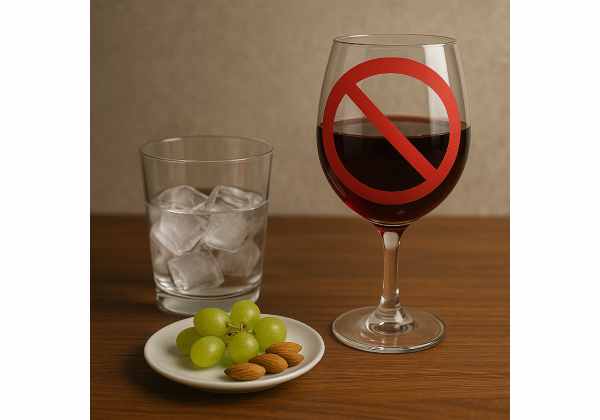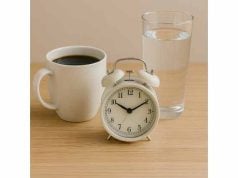
Alcohol can fit into a weight loss plan, but only with clear limits and smart choices. Drinks add calories quickly, loosen restraint, and disrupt sleep—the three forces that most often stall progress. You do not need to quit forever to see results. You do need a plan that caps intake, chooses lower-calorie options, and protects meals and sleep from alcohol spillover. This guide shows how to do that in real life: weekly caps that work, bar and restaurant “order scripts,” food pairings that blunt cravings, and a simple way to track progress without obsessing. If you are also building the habits that make weight loss stick—sleep, stress, daily movement—see our foundation on habits, sleep and stress skills. Use the templates below to start this week and still enjoy social events without derailing momentum.
Table of Contents
- Do Alcohol Habits and Weight Loss Conflict?
- How to Set Limits That Work
- Lower-Calorie Drinks That Satisfy
- Plan Meals and Timing Around Drinks
- Common Mistakes and Fixes
- Who Should Be More Cautious
- Results to Expect and How to Track
- Frequently Asked Questions
Do Alcohol Habits and Weight Loss Conflict?
Alcohol and weight loss can coexist, but they compete on several fronts. Understanding where the friction happens helps you set limits that actually work in the real world.
Calories add up, even before mixers.
Pure alcohol contains about 7 calories per gram. A standard drink (roughly 14 g of pure alcohol) contributes close to 100 calories before you add sugars, juices, or cream. Typical totals:
- 12 oz regular beer (about 5% ABV): 140–180 calories
- 12 oz light beer: 90–110 calories
- 5 oz dry wine: 110–130 calories
- 1.5 oz 80-proof spirits (neat): 90–100 calories
- Cocktails with sweet mixers (margarita, piña colada): 200–400+ calories
Two cocktails and a shared appetizer can quietly equal a full extra meal.
Alcohol changes decision-making.
After one to two drinks, restraint drops and “why not” choices multiply—extra fries, dessert, late-night snacking. That behavior, not the alcohol calories alone, is why many people plateau.
Metabolism and sleep take a hit.
Your body prioritizes clearing alcohol, pausing fat burning until it is metabolized. Later, sleep becomes lighter and fragmented. Poor sleep the same night or next night raises hunger and cravings, nudging you toward higher-calorie foods.
Weekends matter more than weekdays.
Many drink little Monday–Thursday, then overshoot Friday and Saturday. A “clean” week can be undone by a two-night surge of drinks, snacks, and poor sleep. Planning for weekends produces the biggest returns.
You do not need zero; you need guardrails.
A practical, balanced approach includes:
- Clear, weekly caps
- Default drink orders with known calories
- Food rules that protect protein and fiber
- A bedtime boundary when you drink
If you want safe, sustainable weight loss targets to pair with an alcohol plan, review our notes on safe weight loss basics. The caps and choices below fit those guidelines.
How to Set Limits That Work
Limits fail when they are vague (“drink less”) or perfectionist (“never again”). Good limits are clear, pre-decided, and easy to follow when willpower is low. Use these steps to build your plan.
1) Choose a weekly cap
Pick a cap that moves you forward but still fits your life. Common starting points:
- Light social drinker: 3–4 drinks per week, spread out
- Moderate social drinker: 5–7 drinks per week, with 0–2 per day
- Cut-back phase: 0–2 drinks per week for 2–4 weeks to reset habits
The key is pre-allocating drinks to specific days. If your main social time is Saturday, plan for 2 drinks Saturday, 1 drink Friday, and 0 the rest of the week.
2) Set a per-occasion max
Cap single occasions at 1–2 drinks. After your second, switch to a zero-calorie “spacer” like soda water with lime. This is the smallest change that prevents the cascade of snacks, dessert, and poor sleep.
3) Create a default order
Decide your go-to drink before you arrive. Examples:
- Dry wine (5 oz)
- Spirits with soda water and citrus (tall glass)
- Light beer or a 100-calorie hard seltzer
Default orders remove in-the-moment bargaining.
4) Add a hydration rule
Use one-for-one: one glass of water for each drink. Ask for the water in a tall glass at the same time as your order.
5) Pre-commit a “no-drink” routine
On nights you skip alcohol, keep the ritual: pour flavored seltzer in a wine glass, brew herbal tea, or mix a zero-proof spritz. Rituals scratch the itch that alcohol used to fill.
6) Plan for weekends
Write next weekend’s plan by Thursday. Decide the venue, drink count, and meal strategy in advance. If weekends are your sticking point, check practical ideas in our weekend strategies.
7) Use a simple tracker
Log drinks like you track steps: quick, neutral, and nonjudgmental. A checkmark or tally in your notes app is enough. Review totals at a weekly check-in and adjust your cap if needed.
Why this works: You are not relying on willpower at 10 p.m. You are following a plan written at 10 a.m., when your goals are clear. Small, predictable limits consistently beat big, heroic efforts.
Lower-Calorie Drinks That Satisfy
You want options that feel social and enjoyable while keeping calories in check. Use this guide to build a dependable “short menu” you can order anywhere.
Good defaults (roughly 90–130 calories each)
- Dry wine (5 oz): sauvignon blanc, pinot grigio, dry rosé, brut sparkling
- Light beer (12 oz): most brands land around 90–110 calories
- Hard seltzer (12 oz): many are 100 calories, low sugar
- Spirits + soda water (1.5 oz pour): vodka, gin, tequila or whiskey with soda water and a citrus wedge (90–100 calories)
Sometimes options (usually 130–180 calories)
- Regular beer (12 oz): lagers and pilsners
- Dry cider (12 oz): check labels; many range 120–180 calories
- Half-sweet cocktails: ask the bartender to halve the syrup and use soda water to top up
High-calorie choices to keep rare (200–400+ calories)
- Frozen or creamy cocktails (piña colada, mudslide)
- Sweetened margaritas, daiquiris, and long island iced tea
- Full-sugar mixers (tonic, regular soda, full-sweet juice)
How to order lower-calorie cocktails
- Ask for your drink tall (more soda water, same alcohol).
- Request half-sweet or no simple syrup.
- Swap tonic for soda water (tonic adds sugar).
- Choose citrus + bitters to add flavor without sugar.
- If you want spice, add jalapeño or ginger with soda water.
Zero-proof swaps for any night
- Soda water with bitters and lime (most bitters add negligible calories at a dash).
- Nonalcoholic beer (calories vary—many 50–80 calories).
- Iced herbal tea with citrus in a rocks glass.
- Shrub (vinegar syrup) topped with soda water—ask for a small pour of shrub.
Food pairings that help
- If you plan to drink, open the evening with lean protein and high-fiber vegetables. A protein starter reduces the urge to graze through fries and dessert. For easy, visual portioning without calorie counting, see the protein and plate method in tracking without calories.
By keeping a short list of satisfying defaults, you remove guesswork and avoid the sugar-heavy options that push you over your plan.
Plan Meals and Timing Around Drinks
Alcohol affects appetite, sleep, and next-day cravings. Smart timing and meal structure preserve your calorie budget and keep you steady.
Before you drink
- Protein first: Eat 30–40 g of protein in the meal before you drink (e.g., chicken breast, Greek yogurt bowl, tofu stir-fry). Protein steadies appetite and limits later snacking.
- Fiber load: Add a large salad or roasted vegetables. Fiber slows digestion and blunts blood sugar swings.
- Hydration: Drink a full glass of water before you leave. You will sip slower once the first drink arrives.
During the evening
- Alternate beverages: Water → drink → water. Order the water immediately so it is on the table.
- Plate the snacks: If shared food is on the table, plate your portion once and push the bowl away.
- Stop at two: Two standard drinks are the practical ceiling for most weight-loss plans.
After you drink
- Protein top-off: If you are hungry later, choose lean protein + fruit (cottage cheese and berries, yogurt with sliced apple). Skip chips and sweets; they trigger more eating.
- Lights out boundary: Aim to finish drinks 3–4 hours before bed. Alcohol fragments sleep, which raises cravings the next day. If you drink late, enforce a screens-off time and a consistent wake time to limit the spiral.
On restaurant nights
- Front-load vegetables: Order a salad or vegetable side to arrive with your first drink.
- Choose one extra: Either a drink or dessert; not both.
- Sauce on the side: Keeps calories predictable when judgment softens.
On weekends
- Plan your social window instead of a free-for-all from Friday to Sunday. Decide which evening includes drinks and which stays alcohol-free. Write the plan by Thursday night. For appetite control across the day, browse ideas on meal timing for appetite.
Smart timing protects your sleep, your eating decisions, and your weekly calorie deficit—all without turning social plans into stress.
Common Mistakes and Fixes
Even thoughtful drinkers hit snags. Use these targeted fixes to keep progress moving.
“Saving calories” for drinks
Arriving hungry leads to a fast first drink and high-calorie snacks. Fix: Eat a protein-forward meal before you go out, then cap drinks at two.
Forgetting mixers
Juice, tonic, and syrups often double drink calories. Fix: Ask for soda water and citrus, or request half-sweet.
No water rule
Without a spacer drink, your pace climbs. Fix: One-for-one water with each drink, ordered together.
Unlimited weekends
Friday and Saturday pile up calories, poor sleep, and next-day cravings. Fix: Pre-commit to one drink night and one zero-alcohol night. Write it down by Thursday.
Mindless grazing
Bowls of fries or chips keep refilling. Fix: Plate your portion once. Ask staff to remove extra baskets.
Treating the scale like a verdict
Alcohol shifts water balance; weight may jump 0.5–1.5 kg the next morning regardless of fat change. Fix: Track a seven-day average and watch the trend. Do not react to a single spike.
No reset after a big night
One event becomes three days of loose eating. Fix: Run a reset the next morning: tall water, protein breakfast, 10-minute walk after lunch and dinner. For night-time pantry raids, keep tools handy from late-night snacking fixes.
“All or nothing” thinking
A third drink feels like the day is blown, so you add dessert. Fix: Call the audible: stop at three, switch to water, and still protect sleep. The night can end better than it started.
Progress depends on totals, not perfection. A small course correction tonight safeguards the whole week.
Who Should Be More Cautious
Alcohol is not neutral for everyone. If you see yourself in the sections below, tighten limits or skip alcohol entirely until you have a plan with your clinician.
Pregnancy, trying to conceive, or breastfeeding
Avoid alcohol unless your clinician says otherwise.
Liver disease, pancreatitis, ulcers, or inflammatory bowel flares
Alcohol can worsen symptoms and slow healing. Get personalized guidance.
Diabetes or reactive hypoglycemia
Alcohol and certain medications increase the risk of low blood sugar. Eat protein with drinks, monitor levels, and discuss safe limits with your healthcare team.
Sleep apnea or heavy snoring
Alcohol relaxes airway muscles and can worsen breathing disruptions. If you suspect apnea, review signs and next steps in sleep apnea and weight loss and speak with a clinician.
History of alcohol misuse or strong family history
Skip self-experimentation. Seek professional support and consider zero-proof routines.
Mood disorders or anxiety
Alcohol can destabilize mood and sleep. If you notice a link between drinks and low mood, prioritize alcohol-free weeks while you optimize sleep, daylight, and therapy tools.
Athletic goals or weight-class sports
Alcohol reduces sleep quality and muscle recovery. Keep training blocks alcohol-light or alcohol-free.
Safety is success. If cutting back feels hard, or friends push you to overdrink, get help and switch to a zero-proof plan while you build protective routines.
Results to Expect and How to Track
Cutting alcohol is one of the fastest ways to reclaim a weekly calorie deficit and better sleep—two drivers of fat loss. Here is what to expect and how to measure progress without micromanaging.
Realistic impact on calories
- Swapping two 200-calorie cocktails for two 100-calorie drinks each week saves 200 calories.
- Reducing from 7 drinks to 4 per week at ~120 calories each saves 360 calories weekly.
- Taking two alcohol-free weeks often trims 500–1,000 calories and restores deeper sleep, which reduces cravings.
Timeline
- Week 1: Better sleep and steadier appetite on non-drinking days. Daily weight may bounce after drink nights due to water shifts.
- Weeks 2–4: Noticeable changes in waist or morning weight trend if meals support a modest deficit.
- Months 2–3: Alcohol habits feel predictable. Many people keep a small weekly budget or go mostly zero-proof by preference.
How to track without obsession
- Weekly cap tracker: Write your target and tick boxes for each drink. Stop at your cap.
- Seven-day average weight: Weigh most mornings, but look only at the weekly average.
- Sleep and energy notes: Quick 1–5 ratings capture improvements you might otherwise miss.
- Two sentences on Sunday: “Drinks 3/5. Best night was Friday (protein first). Next week: two drinks Saturday, zero Friday.”
When to adjust
- If your seven-day weight trend stalls for two to three weeks and you are consistently hitting protein and movement, trim one drink from your weekly cap or switch one night to a zero-proof option.
- If sleep remains poor after drink nights, move drinks earlier and stop 3–4 hours before bed, or test an alcohol-free month.
What success looks like
- Fewer impulsive snacks on drink nights
- A predictable weekly rhythm (planned drinks, planned zero-proof nights)
- Calmer mornings, steadier energy, and a downward weight trend over months
Track enough to steer, not to fixate. The goal is an enjoyable routine that supports your results and your social life.
Frequently Asked Questions
How many drinks can I have and still lose weight?
Most people progress with 3–7 drinks per week and a cap of 1–2 per occasion, paired with protein-forward meals and good sleep. If your scale trend stalls for two to three weeks, trim one drink or switch one night to a zero-proof alternative and reassess.
Are some alcoholic drinks better for weight loss?
Yes. Lower-calorie options include dry wine, light beer, hard seltzer, and spirits with soda water and citrus. Creamy or frozen cocktails and full-sugar mixers often double or triple calories. Decide a default order before you arrive to avoid high-sugar choices.
Does alcohol stop fat burning?
Your body prioritizes clearing alcohol, so fat burning pauses temporarily. The larger effect comes from higher calories, looser food choices, and disrupted sleep. Keeping to one or two drinks, eating protein first, and finishing drinks several hours before bed reduces the impact.
What should I eat before and after drinking?
Before: 30–40 g protein with vegetables and water. During: alternate water with each drink. After: if hungry, choose lean protein plus fruit and avoid chips or sweets. These steps blunt cravings and keep total calories reasonable without strict rules.
Why does my weight jump after a night out?
Alcohol shifts fluid balance and can increase sodium intake from restaurant foods, causing 0.5–1.5 kg of temporary water weight. Track a seven-day average instead of reacting to one reading. If the average rises for two to three weeks, adjust your weekly cap.
How do I drink less without feeling left out?
Protect the social ritual, not the alcohol. Order a zero-proof spritz in a proper glass, arrive with a conversation plan, and set a clear end time. Choose venues with good alcohol-free options. Commit to one drink night and one alcohol-free night each weekend.
References
- About Standard Drink Sizes | Alcohol Use | CDC — 2024 (Guideline)
- Alcohol Contribution to Total Energy Intake and Its Association with Nutritional Status and Diet Quality in Eight Latina American Countries – PubMed — 2021
- Effects of alcohol on sleep and nocturnal heart rate: Relationships to intoxication and morning‐after effects – PMC — 2022 (RCT)
- Alcohol use and poor sleep quality: a longitudinal twin study across 36 years – PubMed — 2022
- De novo lipogenesis, lipid kinetics, and whole-body lipid balances in humans after acute alcohol consumption – PubMed — 1999 (RCT)
Disclaimer
This article provides general information and education. It is not medical advice and does not replace evaluation, diagnosis, or treatment from a qualified professional. Speak with your clinician about alcohol limits that are safe for you, especially if you have medical conditions, take medications, are pregnant, or have a history of alcohol misuse.
Share and Follow
If this guide helped, consider sharing it with a friend who wants practical ways to keep social life and weight loss aligned. You are welcome to follow us on Facebook, X, or whichever network you use most for steady, no-nonsense strategies you can apply right away.










